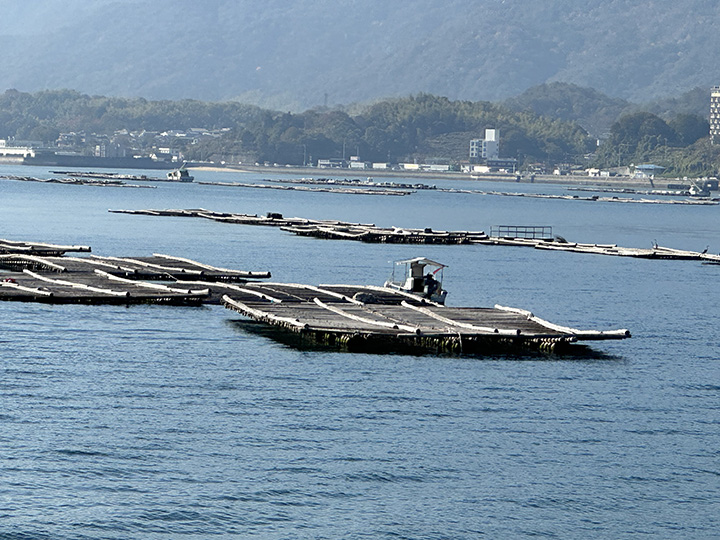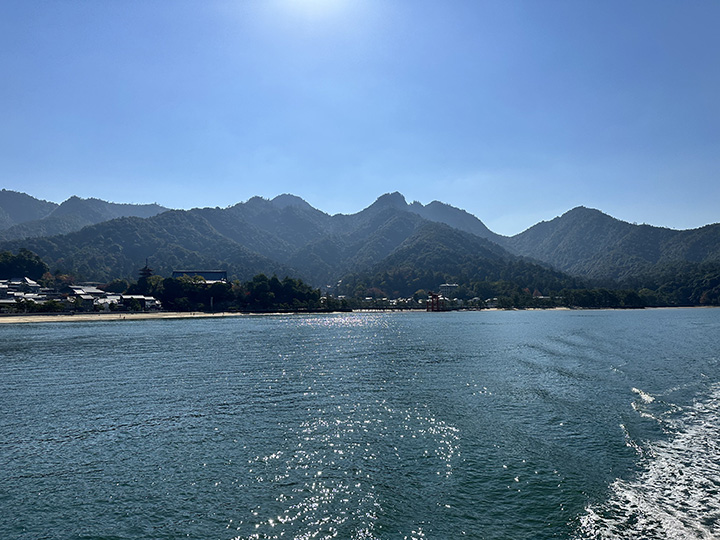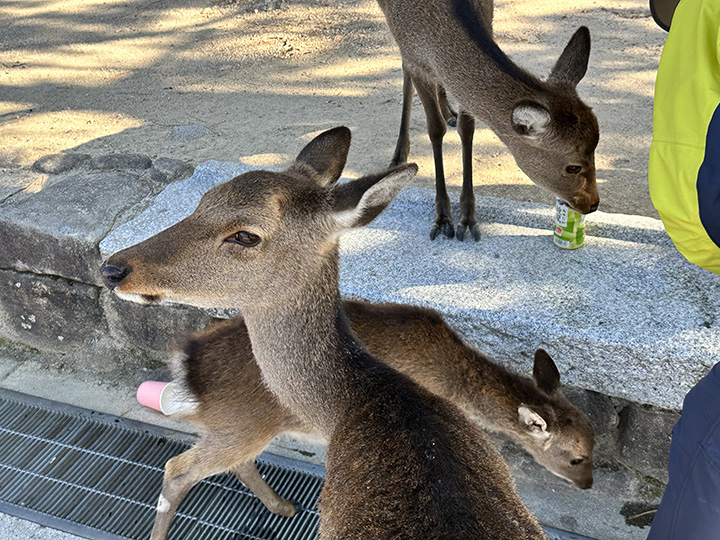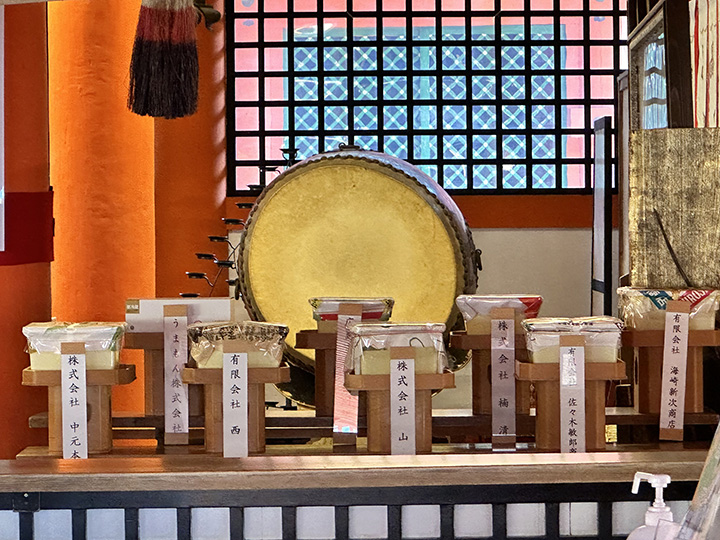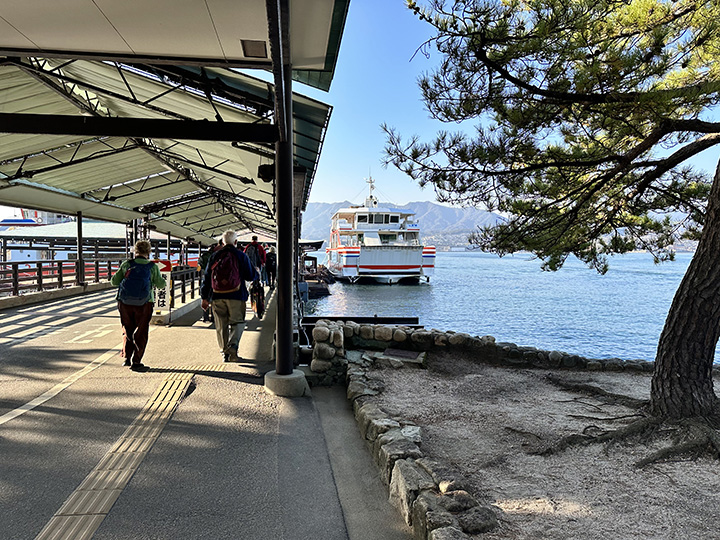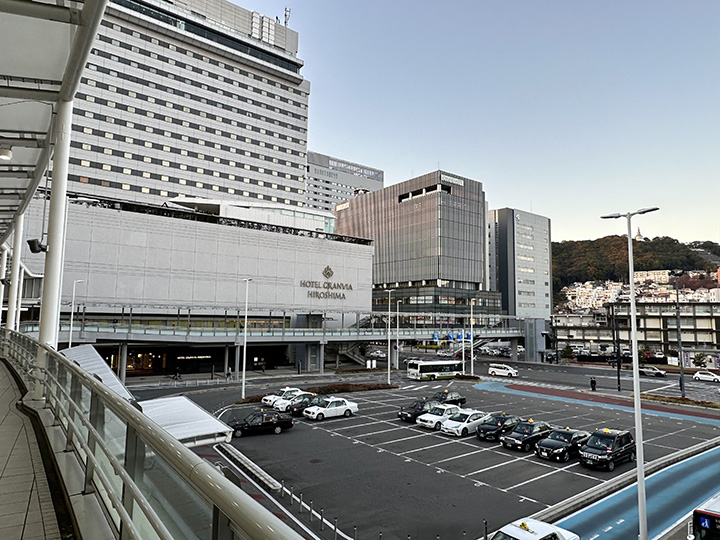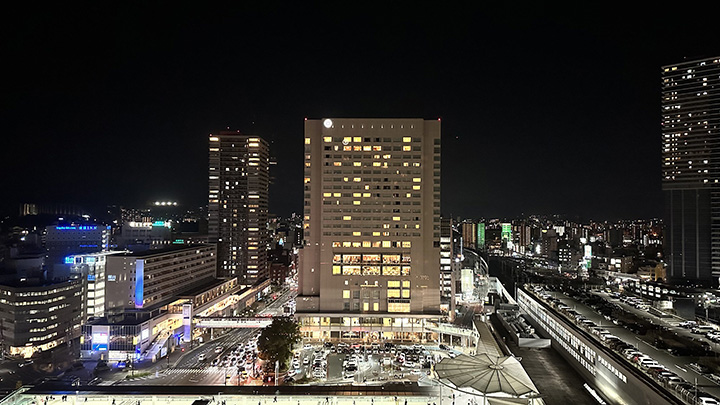|
Today we rode the bullet train again, took a ferry to an island with a long history, walked around a Shinto shrine built on the water, ate some tasty street food, and ended up in Hiroshima.
First a taxi ride to Kyoto station. Hey look! Itís Kyoto Tower!
And there it is reflected in Kyoto station. Is that great or what?
Here comes our Shinkansen bullet train to Hiroshima, where we will transfer to another train.
Itís hard to take pictures from the window of a bullet train because youíre moving so fast.
Just when you think youíve got a nice shot lined up, somethings zooms into the frame.
Here we are.
And here we go again. This train is more like a subway.
And it is taking us to a ferry.
There are boats around here somewhere.
This way, apparently.
OK, there's one ferry boat.
And here comes ours, I hope.
It'll work.
We are going over there to Miyajima Island. It is most famous for its dramatic gate, or torii on the outskirts of the shrine, the sacred peaks of Mount Misen, extensive forests, and its ocean view. The shrine complex itself consists of two main buildings: the Honsha shrine and the Sessha Marodo-jinja, as well as 17 other different buildings and structures that help to distinguish it.
Try to grab a good spot along the rail for sightseeing.
And don't drop your iPhone over the side.
Miyajima has been considered a holy place for most of Japanese history. In 806 AD, the monk Kōbō Daishi ascended Mt. Misen and established the mountain as an ascetic site for the Shingon sect of Buddhism. In the years since, the island's Buddhist temples and Shinto shrines have maintained a close relationship.
Those are oyster farms. This area is noted for producing some of the finest oysters in Japan.
There is the torii for the Itsukushima Shrine, one of Japan's most popular tourist attractions.
The name Itsukushima literally means Ďisland of worshipí and from ancient times the island itself was worshipped as a god. The mystical Itsukushima Shrine built on the water was inscribed as a World Heritage Site in 1996. The island is the site of the events described in one of Japanís greatest works of literature, The Tales of Heike. This is where two medieval warrior clans fought to determine the fate of Japan.
A place where people have long carried out ancient rites, Itsukushima Shrine has become world renowned, attracting visitors from all over Japan and the rest of the world. And we're about to visit it.
Getting the lay of the land.
Now let's go find the shrine.
That's a nice view of where we came from.
It's a dog driving a baby Benz.
The Japanese do pamper their pets. But this guy isn't really driving that thing, right?
The owner has a radio control unit.
There are deer on Miyajima that will steal your food if you let them.
Aww. He looks so hungry.
I wonder if anybody ever uses this beach as a, well, beach? Not today, apparently.
They may look cute...
But when we got off the ferry there was a warning on the loudspeaker that we need to be careful of the deer. They will steal your food right out of your pocket. But worse, they eat paper and they have been known to devour return tickets.
That torii has to be around here somewhere.
Over there.
Bill has found it.
The entire shrine has been built to appear to be floating on water. It is low tide now so you can see the pilings, but when the tide comes in the whole shebang magically seems to float. Kathleen said that when the shrine was built originally, the island itself was considered so sacred that you couldnít build anything on it. Thatís why it had to be built on water. But the Buddhists have abandoned any pretense of that these days.
We are inside the open air shrine.
The main part of the shrine.
The Road Scholars are taking it all in.
If the tide weren't out this would all appear to be floating on the water.
As I mentioned back in Tokyo, Shichi-Go-San (lit. Seven-Five-Three) is a traditional rite of passage for three- and seven-year-old girls and three- and five-year-old boys held annually around November 15. On that day children visit temples or shrines, often in traditional Japanese clothing.
We found a little girl who was charming in her beautiful kimono.
The tide is still out.
A monster guards the place.
It's quite impressive.
Thatís a big drum over there.
Same story here -- the monks get free sake and the sake manufacturers get free advertising.
This is where you tie your prayers.
The buildings look a bit forlorn when the tide is out.
A collection of drawings like this were pinned to the beams along the walkway. They showed what the torii looked like right up until a couple of months ago while it was being refurbished. We were lucky to arrive after all the scaffolding had been removed.
A bridge across water that isn't there.
Momiji Manju are sweet cakes traditionally filled with red bean paste baked in the shape of a maple leaf. They are a local food of Hiroshima, created in Miyajima in the early 20th century. The maple leaf shape represents Momijidani, a popular place in Hiroshima to look at maple leaves. This machine churns them out by the hundreds.
I had one, just one. It was still warm and it was wonderful. Rich and filling, but wonderful.
I thought about the traditional red bean filling, but I settled on custard. Great choice.
Of course there's a Starbucks here. Charley is headed that way.
There were lots of other foods to choose from.
I had mozzarella wrapped in bacon and deep fried. It's was good.
The island had the fanciest public toilet I've ever encountered. I never figured out what tricks it would -- wasn't interested -- but I did find a way to make it flush.
A rickshaw for the tourists.
"Suzanne, you have made a friend."
It's time to head back to the ferry.
The ferry terminal had a clock that did tricks. While I was distracted by the clock, everybody else was retrieving their overnight bags from the lockers in the terminal. I forgot that my bag was in the island terminal and I thought it was in the mainland terminal. I actually rode the ferry back to the mainland without my bag and Kathleen and I had to turn around and ride a ferry back to retrieve it. I was mortified.
So here I am walking to board the ferry without a care in the world.
See the Road Scholars out there with their bags and backpacks? Does Bill have his? Nope.
He's just enjoying the ride which he was about to enjoy all over again.
Kathleen took that picture of a pagoda. She's an excellent photographer.
Here's our hotel by the Hiroshima train station.
The Japanese really do like Christmas.
It was a really nice hotel. That's the view from my windows at dusk.
And that's the view at night.
This hotel was taking no chances with covid. At least nobody was going to cough on my meal.
They even gave us little pouches to put our masks away while we ate.
I ate one of those sardines, eyeballs and all. It wasn't awful, but I didn't eat the other one.
|


















